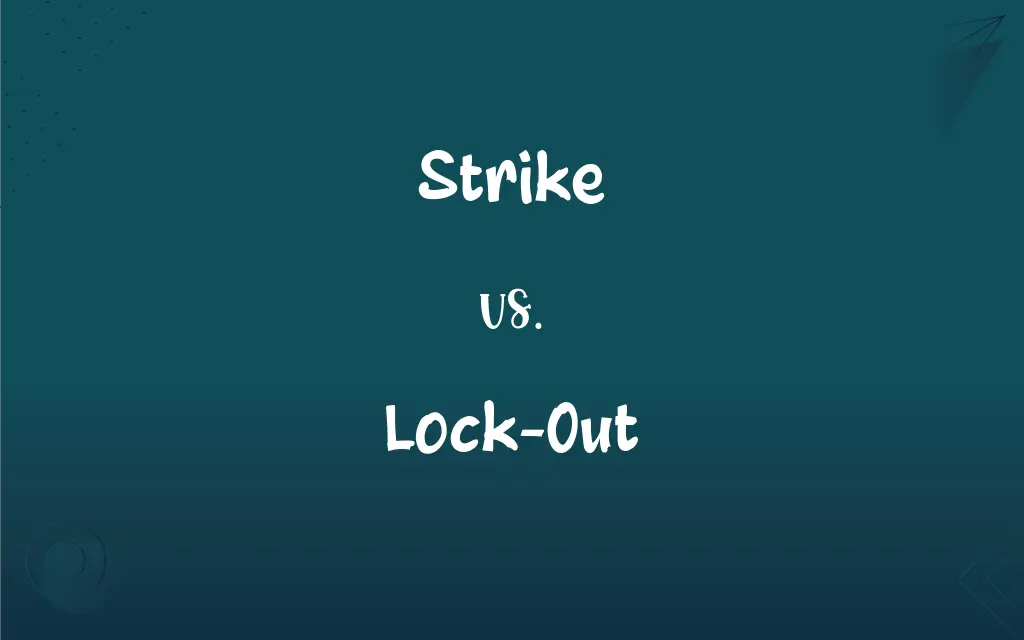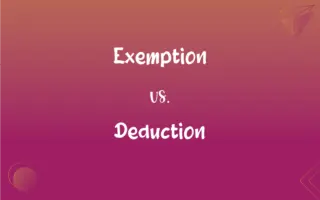Strike vs. Lock-Out: What's the Difference?
Edited by Aimie Carlson || By Janet White || Published on November 23, 2023
A strike is a work stoppage by employees as a protest, while a lock-out is an employer-initiated denial of work access to employees during a dispute.

Key Differences
Strike is an action taken by employees, typically union members, who stop working to protest against their employer’s policies, working conditions, or other labor issues. Strikes are a form of collective bargaining, where workers use the cessation of labor as leverage. Lock-out is initiated by employers, who shut down work sites, denying employees access to their place of work, often to exert pressure during labor negotiations or to prevent anticipated strikes.
During a strike, employees voluntarily refuse to perform their jobs, which can lead to a temporary halt in the company's operations. This is a tactical move to draw attention to their demands or grievances. In a lock-out, employers take a proactive step to close the workplace, preventing employees from working, sometimes as a response to a union's threats of a strike or as part of a bargaining strategy.
The purpose of a strike is often to force the employer to address specific issues such as wages, benefits, or working conditions. Strikers seek to disrupt normal operations to highlight their importance to the organization. Conversely, a lock-out is used by employers to accelerate negotiations or to mitigate the impact of a prolonged dispute. It can also be a tool to prevent potential damage or disruption that might be caused by a strike.
Strikes are a right protected in many legal frameworks, allowing workers to collectively express their dissatisfaction. They often involve picketing and public demonstrations. Lock-outs, while also legal in many jurisdictions, are a more aggressive tactic by employers and can sometimes lead to legal and public relations challenges, especially if deemed to be unjust or overly harsh.
The resolution of a strike typically involves negotiation and compromise, leading to a new agreement or an improvement in conditions. The end of a lock-out usually occurs when employers reopen their doors, often after reaching an agreement with the union or when they decide to resume operations under existing terms.
ADVERTISEMENT
Comparison Chart
Initiator
Employees/Workers
Employers
Purpose
To protest for better terms or conditions
To exert pressure during negotiations or prevent strikes
Nature
Voluntary cessation of work by employees
Employer-enforced denial of work access
Legal Protection
Often legally protected as a right
Legal but may have complex implications
Outcome
Seeks resolution through negotiation
Often aims to expedite negotiations or mitigate dispute impact
ADVERTISEMENT
Strike and Lock-Out Definitions
Strike
Refusal to work as a bargaining tool.
The union declared a strike to negotiate the contract terms.
Lock-Out
Preventive action by employers against potential strikes.
The lock-out was used to preempt the anticipated work stoppage.
Strike
A collective action by workers to express grievances.
The strike was called to improve working conditions.
Lock-Out
An employer's action to deny workers access to the workplace.
The company initiated a lock-out during the labor dispute.
Strike
A work stoppage by employees as a protest.
The workers went on strike for higher wages.
Lock-Out
Closure of work site by an employer during a dispute.
The management declared a lock-out to prevent the strike.
Strike
An organized protest against employer policies.
The employees staged a strike against the layoffs.
Lock-Out
Employer’s tool to pressure workers in negotiations.
The lock-out was a response to the union's demands.
Strike
Workforce withdrawing labor to enforce demands.
The strike effectively halted production.
Lock-Out
An employer tactic in labor disagreements.
The lock-out aimed to bring the union back to the negotiating table.
Strike
To hit sharply, as with a hand, fist, weapon, or implement
Struck the table in anger.
Strikes the ball with a nine iron.
Struck the nail with a hammer.
Lock-Out
Alternative form of lockout
Strike
To inflict (a blow).
Strike
To penetrate or pierce
Was struck in the leg by a bullet.
FAQs
Who initiates a strike?
Strikes are initiated by employees, often through a union.
What is a strike?
A strike is a work stoppage by employees to protest against conditions or policies.
What are common reasons for a strike?
Common reasons for a strike include demands for better pay, benefits, or working conditions.
What is a lock-out?
A lock-out is when employers temporarily close the workplace to exert pressure during labor disputes.
Who initiates a lock-out?
Lock-outs are initiated by employers.
Are lock-outs legal?
Lock-outs are legal in many places, but their legality depends on labor laws and the context.
What happens during a strike?
During a strike, employees stop working and may picket or protest to publicize their demands.
What is the purpose of a lock-out?
The purpose of a lock-out is to pressure employees in negotiations or prevent an imminent strike.
What rights do workers have during a lock-out?
Workers' rights during a lock-out depend on local labor laws and their employment contract.
How do lock-outs end?
Lock-outs usually end when employers reopen the workplace, often after reaching an agreement.
Can striking workers be replaced?
The legality of replacing striking workers varies, depending on labor laws and contracts.
What happens during a lock-out?
During a lock-out, employees are denied access to their workplace, halting regular operations.
Can a lock-out lead to negotiations?
A lock-out can lead to negotiations, often serving as a catalyst to bring parties to the table.
Are strikes legal?
Strikes are generally legal but subject to specific laws and regulations in different jurisdictions.
What is a picket line in a strike?
A picket line is where striking workers gather, often outside their workplace, to demonstrate.
How do strikes end?
Strikes typically end with negotiations leading to an agreement or compromise.
What are the risks of a lock-out for employers?
Lock-outs risk legal challenges, damage to public image, and potential loss of productivity.
Is compensation available during a lock-out?
Compensation during a lock-out depends on labor laws and individual employment agreements.
How do strikes affect businesses?
Strikes can disrupt operations, affect productivity, and impact public image.
Can non-union workers strike?
Non-union workers can strike, but their protections may differ from those in unions.
About Author
Written by
Janet WhiteJanet White has been an esteemed writer and blogger for Difference Wiki. Holding a Master's degree in Science and Medical Journalism from the prestigious Boston University, she has consistently demonstrated her expertise and passion for her field. When she's not immersed in her work, Janet relishes her time exercising, delving into a good book, and cherishing moments with friends and family.
Edited by
Aimie CarlsonAimie Carlson, holding a master's degree in English literature, is a fervent English language enthusiast. She lends her writing talents to Difference Wiki, a prominent website that specializes in comparisons, offering readers insightful analyses that both captivate and inform.






































































